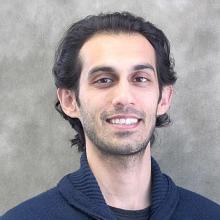PNNL at EGU23
Earth scientists share insights at the annual General Assembly of the European Geosciences Union, held in Vienna, Austria

Vienna, Austria + hybrid
The annual General Assembly of the European Geosciences Union features a mix of in-person and virtual thought-provoking talks and posters. The hybrid event is planned for April 23–28, following Earth Day 2023, in Vienna, Austria.
Many researchers from Pacific Northwest National Laboratory (PNNL) will be participating in this year's conference and would like to meet you. And if you're a scientist or engineer interested in working at PNNL, check out our current openings in Earth science:
Selected PNNL Presentations
Atmospheric Moisture Intrusion into the Arctic: Sources, Impact, and Trends

EGU23-10197 | Monday, April 24 at 11:45–11:55 A.M. (CEST)
PNNL Authors: Hailong Wang (presenter), Rudong Zhang, Yufei Zou, Weiming Ma, and Philip Rasch
Summary: Atmospheric water vapor plays an enormously important role in the water cycle and energy budget of the Arctic. Water vapor in the Arctic also participates in many important feedback mechanisms influencing the climate response to forcing agents and the Arctic amplification. In this study, we conduct analysis of atmospheric moisture transport into the Arctic based on reanalysis products and CMIP6 model simulations. We are particularly interested in the episodic atmospheric-river-like features (AR or moisture intrusion) that play an important role in delivering water to the Arctic. READ MORE.
Foresight – Global Change Analytics: Communicating Complex Science through Interactive Dashboards

EGU23-4534 | Tuesday, April 25 at 08:45–09:05 A.M. (CEST)
PNNL Authors: Zarrar Khan (presenter), Chris Vernon, Taryn Waite, and Hassan Niazi
Summary: As scientific models continue to grow in complexity and the level of detail they capture, so too does the size and complexity of the data outputs. Managing the overwhelming amounts of data and curating it into key insights and messages following FAIR (findability, accessibility, interoperability, and reusability) data principles can promote effective communications among scientific teams. This talk presents the ongoing development of “Foresight,” an online platform to visualize and interact with data outputs from the Global Change Intersectoral Modeling System (GCIMS) eco-system of human-Earth system models. READ MORE.
Influence of Drying on Riverine Sediment Biogeochemistry across the Contiguous United States

EGU23-10521 | Friday, April 28 at 10:50–11:10 A.M. (CEST)
PNNL Authors: James Stegen (presenter), Kenton Rod, Maggi Laan, Dillman Delgado, Sophia McKever, Lupita Renteria, Amy Goldman, Brieanne Forbes, Matthew Kaufman, Vanessa Garayburu-Caruso, and Brianna Gonzalez
Summary: Global change is altering where and when there is enough water for streams to flow. This leads to changes in where and when riverine sediments are inundated with an overlying water column, and affects the associated wet/dry dynamics those sediments experience. A current knowledge gap is how respiration rates in re-wetted sediments compare to sediments that are consistently inundated, and what factors govern the effect-size of drying on respiration. To help address this gap, we are conducting a manipulative laboratory experiment using sediments from the shallow hyporheic zone (~5 cm into the riverbed). READ MORE.
Selected PNNL Posters
Quantifying Airborne Fraction Trends and the Ultimate Fate of Anthropogenic CO2 by Tracking Carbon Flows in a Simple Climate Model

EGU23-3680 | Monday, April 24 at 08:30–10:15 A.M. (CEST)
PNNL Authors: Leeya Pressburger (presenter), Kalyn Dorheim, Trevor Keenan, Haewon McJeon, Steve Smith, and Ben Bond-Lamberty
Summary: Carbon dioxide (CO2) concentrations have increased in the atmosphere as a direct result of human activity and are at their highest level over the last 2 to 3 million years, with profound impacts on the Earth system. However, the magnitude and future dynamics of land and ocean carbon sinks are not well understood; therefore, the amount of anthropogenic fossil fuel emissions that remain in the atmosphere (the airborne fraction) is poorly constrained. This work aims to quantify the sources and controls of atmospheric CO2, the fate of anthropogenic CO2 over time, and the trend and robustness of the airborne fraction. We use Hector v3.0, a coupled simple climate and carbon cycle model, with the novel ability to explicitly track carbon as it flows through the Earth system. READ MORE.
STITCHES: A Comprehensive Option for Earth System Model Emulation for Impacts Research, and its Implications for Designing Future ESM Scenario Experiments

EGU23-10246 | Monday, April 24 at 08:30–10:15 A.M. (CEST)
PNNL Authors: Kalyn Dorheim (presenter), Haewon McJeon, Steve Smith, and Ben Bond-Lamberty
Summary: Emulators of Earth system model (ESM) outputs have the potential to become a powerful tool for the impacts research community. If successful in emulating the needed variables at the required spatial and temporal resolution, they can supply impact model(er)s with the inputs necessary to explore how future water, energy, economic, and land systems evolve under a wide range of future scenarios. This complements the availability of ESM output currently limited to a small number of future scenarios — due to the computational costs of running fully coupled climate models — since emulators are by construction computationally efficient. STITCHES is an open-source climate emulator that can produce time series of multiple ESM variables, at the ESM original temporal and spatial resolution, by recombining existing model output into new scenarios on the basis of the scenario global temperature trajectory. READ MORE
GCIMS – Integration: Reproducible, Robust, and Scalable Workflows for Interoperable Human-Earth System Modeling
EGU23-4525 | Wednesday, April 26 at 08:30–10:15 A.M. (CEST)
PNNL Authors: Zarrar Khan (presenter), Chris Vernon, Isaac Thompson, and Pralit Patel
Summary: The number of models, as well as data inputs and outputs, are continuously growing as scientists continue to push the boundaries of spatial, temporal, and sectoral details being captured. This study presents the framework being developed to manage the Global Change Intersectoral Modeling System (GCIMS) ecosystem of human-Earth system models. We discuss the challenges of ensuring continuous deployment and integration, reproducibility, interoperability, containerization, and data management for the growing suite of GCIMS models. READ MORE.
The Life Cycle of Snow in the Sierra Nevada USA: From Snowfall to Snowmelt and Effects on Endangered Bighorn Sheep

EGU23-3776 | Wednesday, April 26 at 4:15–6:00 P.M. (CEST)
PNNL Authors: Yun Qian (presenter)
Summary: Snow is a valuable resource in California. Snow from the Sierra Nevada sustains a diverse ecosystem and provides 75 percent of California’s Agricultural water supply. Because of its importance in water supply and global climate, snow accumulation, melt, and sublimation were ranked as the most important objectives in the 2017 Decadal Survey. This study employs a fully coupled meteorology‐chemistry‐snow model to investigate the impacts of both global warming and light‐absorbing particles (LAPs) on snow in the Sierra Nevada. The results will be used to examine snow effects on endangered Sierra Nevada bighorn sheep and how a future climate might modify habitat and behavior. READ MORE.